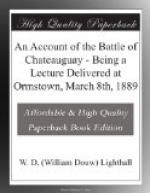Captain Daly is the name to be mentioned next to De Salaberry. His courageous onslaught is testified to by both Purdy and the Temoin, and twice wounded, he fought until he fell. It may be truthfully said that it was he who bore the brunt of the fight. Schiller also specially distinguished himself, and won his captaincy on the field. Of Ferguson and the two Captains Duchesnay we have spoken. The Temoin Oculaire praises the courage of Captain La Mothe, of Lieuts. Pinguet, Hebden, Guy, Johnson, Powell, and Captain L’Ecuyer (the latter two for captures of prisoners in the woods.) Captains Longtin and Huneau, of the Beauharnois Militia, are also mentioned by him for good conduct. Louis Langlade, Noel Annance, and Bartlet Lyons, of the Indian Department, were in the action of the 26th and the affair of the 28th. McDonell of Odgensburg, and no doubt many others, ought to be added. As to credit, in fact, every man in the region who did his duty and was ready to defend his country deserves it, and those named are but the examples who were put to the test. The brave Scotch settlers, few as they then were, were inspired with that spirit. The women stood literally ready to burn the roofs over their heads. The men, except those who had teams, who were drafted into an invaluable transport service, were formed into a company and drilled for the defence, under Lieut. Neil Morison and Captain James Wright, whose house was the headquarters of General De Watteville and a frequent scene of the council of officers. He was a tall and stern man, a Highlander, his name of “Wright” being a translation of his Gaelic one, “MacIntheoir.” His Chateauguay sword is said to have long hung on the wall in the house of one of his descendants.
We should not be so ungrateful also as to forget the services of those faithful Indians, to whom, as all through the war, a share of the success was due.
In 1847 it was decided in England, after much agitation, to issue what was called “the War Medal,” rewarding all those who had fought British battles during the years 1793 to 1814 and not received any special medal. Clasps were attached for each battle in which the recipient was engaged. A medal seems to have been given, as was meet, to almost every one on the field of Chateauguay, for 260 were distributed. It was, in fact, erroneously issued to some who were not present. One lieutenant, in particular, says Mr. Dion, is known from the De Salaberry letters to have himself lamented that he only came up the day after. The Indians and regulars also got medals. The simple record of what was done, however, is the best memorial of honor to those who were present on that memorable day.
Mr. R.W. McLachlan relates his recollections of one of the veterans at Montreal. “Clad in an old artillery uniform, he was always seen marching out alongside of the troops on review days. He was ever ready to recount his adventures on the day of battle. Although we have heard it often from his lips, all that we can remember is that: ’De Yankee see me fore I see him, and he shoot me drough de neck.’”




